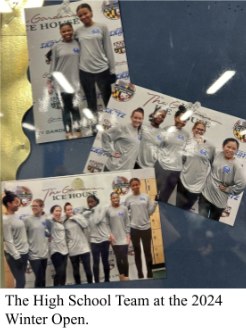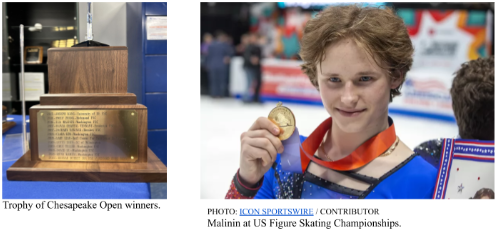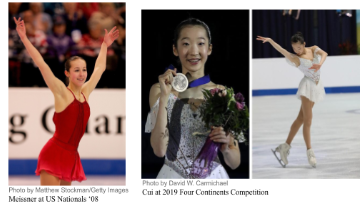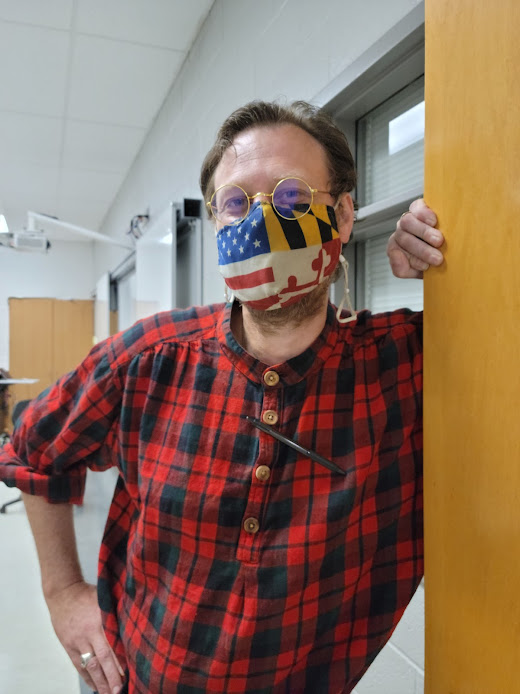 The Baltimore Figure Skating Club’s High School Team visited the Garden’s Icehouse, a skater’s paradise with 6 different ice rinks, on Jan. 15, to participate in the 2024 Winter Open competition. They had an absolute blast and even won the first and second place spots in the artistic competition!
The Baltimore Figure Skating Club’s High School Team visited the Garden’s Icehouse, a skater’s paradise with 6 different ice rinks, on Jan. 15, to participate in the 2024 Winter Open competition. They had an absolute blast and even won the first and second place spots in the artistic competition!
Now, this information may confuse you, since not many people know about Baltimore’s skating community. Figure skating is often thought of as an impossible and inaccessible sport, but it is not, especially in this region. There are many local rinks along with a great community waiting to help you get started.
The Baltimore Figure Skating Club offers a supportive environment for skaters of all skill levels; whether you have been comfortable on the ice ever since you could walk, or you find yourself gripping the walls for dear life, barely able to stand. They provide access to all sorts of competitions, such as the 2024 Winter Open, as seen above, and do so much more to assist skaters in the community. While most people are unaware that this club exists, it has been around since 1939! They are based at Mt. Pleasant Ice Arena, which is only a 10-minute drive from Carver Center. Whether you’re a complete beginner who has only skated in your dreams or an experienced skater who’s looking for more skating opportunities, this club can help you accomplish your skating goals.
On Feb. 12, I had the honor of going to Mt. Pleasant Arena and interviewing several leaders of the club during a learn-to-skate session. I left the rink buzzing with excitement, holding several helpful pamphlets and a pin advertising an upcoming competition.
The first thing I noticed upon arriving at the rink was the assortment of people learning on the ice. I saw some people doing jumps and spins while coaches demonstrated how to improve their technique. I also saw other people learning much more basic moves, such as stroking (which is regular skating) and how to go backward. The range of people didn’t only vary in skill, but also in age. There were little kids, no older than early Elementary school, and grown adults, all being taught how to skate. When asking about the program these people were a part of, I was surprised at how accepting this club is to skaters of all different levels.
The Learn-to-Skate program started only last year but has grown to over 80 members already. The club has been doing all sorts of programs to encourage people to begin skating, especially since so many people are interested in the sport but unsure how to begin. This specific program is for anyone looking to sharpen their skills in a group setting, which is a perfect place for beginners to begin skating!
Skate Academy includes an hour-long mix of practice time and lessons, 30 minutes of each. Coaches teach the basics of skating to any student willing to learn. A cool feature of this program is that parents of members can get on the ice with their kids during practice time.
Judy Carrig, president of the club, discussed the recent hardships the BFSC has faced since the pandemic. Many people quit skating after the virus started, especially since local rinks were closed. Right before Covid broke out, Mt. Pleasant Ice Arena began renovations. Covid stretched those renovations out, and only recently has the club taken off again. Since so many people left, Carrig stated that Covid essentially “killed the sport.” Now, the club has developed many programs to bring popularity back to the sport, such as Learn-to-Skate.
 Other programs that the BFSC offers include Aspire, a program for skaters of all ages who have passed the basic skating levels, and the High School Skate program. Both groups meet every Sunday for two hours, including off and on-ice practicing with coaches.
Other programs that the BFSC offers include Aspire, a program for skaters of all ages who have passed the basic skating levels, and the High School Skate program. Both groups meet every Sunday for two hours, including off and on-ice practicing with coaches.
The High School Team, also called the Baltimore Blue Blades, is open to all levels and can be a great opportunity for Carver students looking to start skating! This team is a recent addition to the club, and it has helped many skaters grow in skill and dedication. Each member of the group is welcomed and able to socialize with other skaters their age. While skating can often be a lonely sport, especially for solo skaters, this is a good way to make it more motivating and fun.
A mother of a 16-year-old Baltimore Blue Blade shares her praise for this program: “The high school program is such a cool program because it incorporates and invites kids of any level, grades. 9-12, and they’ve really formed a close-knit bond…They just have fun. Yes, you get to come, and you get to ice skate, but when you know you’re going to see your friends, you want to come more.”
Although this mother’s daughter has been skating since she was 9, the team is open to all levels, regardless of skill. While working with advanced skaters can be intimidating, the members are very welcoming and will encourage any high schoolers who join to become better skaters.
Another good program that the BFSC created is Aspire. This group consists of more advanced skaters who have already finished the beginner levels. While the High School Skate program is probably a better fit for most Carver Center students, if you are looking to pursue skating after high school, this group may be a good way to do it.
Aspire is at the same time as High School Skate and they work together a lot but still do separate activities. They are offered many similar opportunities, though, in terms of competitions and skating hours. While joining these teams means you will have lessons in 7-to-11-week increments every Sunday, you are also offered similar ice hours. Every Monday from 6:10 – 7 p.m and 7:10 – 8 p.m, in addition to Thursdays for 3 hours, the BFSC hosts free skate sessions. While these sessions are pricier than public sessions, the benefits make it worth the extra money. Usually, at public sessions, kids are zooming around, people racing, going uncomfortably close to you, and not much room to practice and improve skills. At the BFSC free skate sessions, it is much less like the Hunger Games and instead organized and peaceful. These sessions are cheaper for members of the club but still open to anyone, regardless of whether they are a part of the BFSC.
Not only does the BFSC offer peaceful ice time for practice, but they also host parties! As previously stated, this sport can be particularly lonely. Three times a year, the BFSC hosts free holiday-related parties with snacks to combat this loneliness and create a fun, motivating environment for skaters. These three parties include a winter holiday party and exhibition, a Halloween party, and a spring exhibition. The 2023 Halloween party had over 100 people, each wearing very cool costumes. Whether you’re into skating or not, these parties always promise a blast. This year, the spring exhibition will be on May 5, and even if you aren’t interested in skating yourself, the showcase will be a fun watch.
While there are many things the BFSC does to make the sport fun, they take practice very seriously. Coaches who teach in the Learn-to-Skate Academy or High School Skate and Aspire are chosen carefully. Skating is very dependent on muscle memory, meaning that repetition is the key to success. When repeating a move, your mind and body begin to remember it and do it on command. If someone learns a move the wrong way, it takes a lot of time to relearn it and get rid of those bad habits. Because of this, the way students are taught is essential to ensure that skaters are learning properly and will be able to advance without needing to reteach themselves. The BFSC hires qualified coaches whom the students can learn well from. After all, you can only become as good as your teacher, and if they are not trained properly, you won’t be either.
This sport is unique, and there is a lot that goes into being able to practice it consistently.
First off, access to a rink is the most essential thing. Most rinks are privately owned and not always supportive of figure skating clubs, especially since ice time must also be shared with hockey teams. A local example of this is the Worthington Figure Skating Club, located at Reisterstown Sportsplex. Reisterstown Sportsplex isn’t as available to figure skaters as Mt. Pleasant Ice Arena is, so the club will not be running anymore soon. While there are hockey teams who use Mt Pleasant’s rink, the arena prioritizes both figure skating and ice hockey, allowing the BFSC ample ice time year round, which is very uncommon.
Another important aspect of the sport is equipment. If a skater does not have good skates or gear, such as guards for their blades or soakers to prevent rust, they will not be able to thrive at the sport. Skating is an incredibly expensive sport, from competition fees to the cost of good-quality equipment, outfits, and club membership expenses. The farther a person gets into ice skating, the more expensive it gets. Beginner skates range from $150-200, which truly isn’t a bad price in comparison to many other sports, and starter lessons are cheap. As you advance, though, skates need to have more support for things like jumps and spins. Other fees arise too, such as competition entry fees and the increased prices of personal coaches once a student moves beyond the basics. Although some of these things are out of the BFSC’s control, they do their best to accommodate the high prices in this sport. The BFSC hosts a Nearly New Sale, selling gently used skating equipment, including dresses, guards, soakers, and skates. Their last Nearly New Sale was on Nov. 27, so they won’t be having one for a little while, but this is a great opportunity if you’re looking to start skating!
As previously mentioned, motivation is a big part of this sport. Being able to come to the rink consistently depends on how much you are enjoying the sport. BFSC does a great job of engaging skaters and creating a fun environment, but many individual aspects of motivation are important too. A supportive environment is important for all skaters. A hard-working volunteer for the club and mother of a member shares this improvement advice: “When your child is committed to ice skating, you have to be dedicated, because the only way you can get better is with practice. You have to put in a lot of time at the rink. People go, ‘Well, why can’t I skate?’ The whole thing about this sport is that it’s all about repetition. If they stop learning, their muscles will forget.”
Something very special about this club is that it is run solely by volunteers. Many parents who are supportive of their child’s hobby volunteer to help, from scheduling ice time to running tables.
Even if you aren’t interested in skating yourself but enjoy watching the sport, the BFSC creates many opportunities for that too. Possibly the biggest thing that the BFSC does is host the Chesapeake Open Competition. This competition is held annually in the spring at the Garden Icehouse. It is huge, with people coming from all over the country and even overseas. This year, the Chesapeake Open will be from June 19 – 22. Many kinds of skaters compete, but there are a lot of preliminary tests that need to be passed to participate in this.
During the interview, Carrig, the club’s president, brought me to a bookcase, displaying many of the BFSC accomplishments. Inside there were a few trophies, and some of which were engraved with the names of winners of the Chesapeake Open.
When pulling out a trophy to show me, Carrig asked, “Do you know Ilia Malinin?” I audibly gasped.
If you know anything about figure skating, you’ve heard about Malinin, the first person to land a quadruple axel in competition. He’s also referred to as the “Quad God,” since he lands so many quadruple jumps.
Well, Malinin competed at the Chesapeake Open in 2016, and his name was on the trophy of winners!

In addition to hosting this awesome competition, the BFSC has also had many members who have gone on to become famous skaters.
Kimmie Meissner came from the BFSC club and competed in the 2006 Olympics, placing sixth. She won the World Championship in 2006, was the 2007 Four Continents champion, and US National champion that same year.

Recently, Ting Cui has been a big skater emerging from the BFSC. She recently sustained an injury but has gotten back on the ice in hopes of continuing to compete. That’s the biggest problem with skating: you get injured all the time. Cui placed 11th in the Four Continents championship, was the 2018 US Junior national bronze medalist, and the 2019 Junior Worlds bronze medalist.
All in all, the BFSC has had many achievements and is a great, local opportunity waiting to be grabbed. In this figure skating club, you aren’t limited to solo skating, but can also do pair skating, couples skating, ice dancing, synchronized skating, or even theater on ice (which is great for Carver kids). If you’ve always wanted to be a figure skater, this can be what takes you to the next step. There is a lot of information on the BFSC website if you want to join, where you can see upcoming dates, how to register, ice times, and lots of other facts that could be helpful. With some practice, perhaps your name could sit alongside the likes of Malinin, Meissner and Cui!









